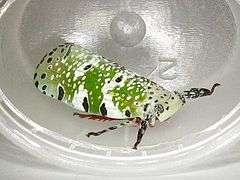Planthopper
A planthopper is any insect in the infraorder Fulgoromorpha:[1] in the suborder Auchenorrhyncha[2] and exceeding 12,500 described species worldwide. The name comes from their remarkable resemblance to leaves and other plants of their environment and from the fact that they often "hop" for quick transportation in a similar way to that of grasshoppers. However, planthoppers generally walk very slowly so as not to attract attention. Distributed worldwide, all members of this group are plant-feeders, though surprisingly few are considered pests. The infraorder contains only a single superfamily, Fulgoroidea. Fulgoroids are most reliably distinguished from the other Auchenorrhyncha by two features; the bifurcate ("Y"-shaped) anal vein in the forewing, and the thickened, three-segmented antennae, with a generally round or egg-shaped second segment (pedicel) that bears a fine filamentous arista.
| Planthopper | |
|---|---|
.jpg) | |
| Phromnia rosea (Flatidae) adults and nymphs | |
| Scientific classification | |
| Kingdom: | Animalia |
| Phylum: | Arthropoda |
| Class: | Insecta |
| Order: | Hemiptera |
| Suborder: | Auchenorrhyncha |
| Infraorder: | Fulgoromorpha Evans, 1946 |
| Families | |
Overview
Nymphs of many fulgoroids produce wax from special glands on the abdominal terga and other parts of the body. These are hydrophobic and help conceal the insects. Adult females of many families also produce wax which may be used to protect eggs.[3]
.jpg)
Fulgoroid nymphs also possess a biological gear mechanism at the base of the hind legs, which keeps the legs in synchrony when the insects jump. The gears, not present in the adults, were known for decades[4] before the recent description of their function.[5]
Planthoppers are often vectors for plant diseases, especially phytoplasmas which live in the phloem of plants and can be transmitted by planthoppers when feeding.[6]
A number of extinct members of Fulgoroidea are known from the fossil record, such as the Lutetian-age Emiliana from the Green River Formation (Eocene) in Colorado.[7]
Classification
As mentioned under Auchenorrhyncha, some authors use the name Archaeorrhyncha as a replacement for the Fulgoromorpha.
The extant families of Fulgoroidea are:[3]
- Acanaloniidae
- Achilidae
- Achilixiidae
- Caliscelidae
- Cixiidae
- Delphacidae
- Derbidae
- Dictyopharidae
- Eurybrachidae (= Eurybrachyidae)
- Flatidae
- Fulgoridae
- Gengidae
- Hypochthonellidae
- Issidae (sometimes includes Caliscelidae)
- Kinnaridae
- Lophopidae
- Meenoplidae
- Nogodinidae
- Ricaniidae
- Tettigometridae
- Tropiduchidae
Gallery

 Flatolystra verrucosa (Fulgoridae)
Flatolystra verrucosa (Fulgoridae) nymphal Dictyophara europaea (Dictyopharidae)
nymphal Dictyophara europaea (Dictyopharidae)
 Paropioxys jucundus (Eurybrachidae)
Paropioxys jucundus (Eurybrachidae)
Notes
- Evans, JW (1946). "A natural classification of leaf-hoppers (Jassoidea, Homoptera). Part 1. External morphology and systematic position". Transactions of the Royal Entomological Society of London. 96 (3): 47–60. doi:10.1111/j.1365-2311.1946.tb00442.x.
- Song, N.; Liang, A.-P.; Bu, C.-P. (2012). "A Molecular Phylogeny of Hemiptera Inferred from Mitochondrial Genome Sequences". PLOS ONE. 7 (11): e48778. doi:10.1371/journal.pone.0048778. PMC 3493603. PMID 23144967.
- C. H. Dietrich in Resh, V. H. & Carde, R. T. (Eds.) 2003 Encyclopedia of Insects. Academic Press.
- K. Sander. 1957. Bau und Funktion des Sprungapparates von Pyrilla perpusilla WALKER (Homoptera - Fulgoridae). Zool. Jb. Jena (Anat.) 75, 383–388
- Burrows, M.; Sutton, G. (2013). "Interacting Gears Synchronize Propulsive Leg Movements in a Jumping Insect". Science. 341 (6151): 1254–1256. doi:10.1126/science.1240284. PMID 24031019.
- Lee; et al. (2000). "Phytoplasmas: phytopathogenic mollicutes". Annual Review of Microbiology. 54: 221–255. doi:10.1146/annurev.micro.54.1.221. PMID 11018129.
- Shcherbakov, D. (2006). "The earliest find of Tropiduchidae (Homoptera: Auchenorrhyncha), representing a new tribe, from the Eocene of Green River, USA, with notes on the fossil record of higher Fulgoroidea" (PDF). Russian Entomological Journal. 15 (3): 315–322. Archived from the original (PDF) on 2012-04-02.
References
- Wilson, Stephen W. (2005). "Keys To The Families Of Fulgoromorpha with emphasis on planthoppers of potential economic importance in the southeastern United States (Hemiptera: Auchenorrhyncha)" (PDF). Florida Entomologist. 88 (4): 4. doi:10.1653/0015-4040(2005)88[464:KTTFOF]2.0.CO;2. Archived from the original (PDF) on 2010-12-06.
- Bourgoin T. 1996-2015. FLOW (Fulgoromorpha Lists on The Web): a world knowledge base dedicated to Fulgoromorpha. https://web.archive.org/web/20140111091457/http://www.hemiptera-databases.org/flow/
- Larivière, M.-C.; Fletcher, M.J.; Larochelle, A. 2010: Auchenorrhyncha (Insecta: Hemiptera): catalogue.Fauna of New Zealand, (63)
- Swzedo J.; Bourgoin T.; Lefèbvre, F. 2004: An annotated catalogue of Fulgoromorpha, :37-137. In: Fossil Planthoppers (Hemiptera: Fulgoromorpha) of the world. An annotated catalogue with notes on Hemiptera classification. Swzedo, J., Th. Bourgoin & F. Lefèbvre. J. Swzedo edt., Warsaw 2004, 199 pp + 8 pl.
External links
| Wikispecies has information related to Fulgoroidea |
| Wikimedia Commons has media related to Fulgoromorpha. |
- Metcalfa pruinosa, citrus flatid planthopper on the University of Florida/IFAS Featured Creatures website
- Ormenaria rufifascia, a flatid planthopper on the University of Florida/Institute of Food and Agricultural Sciences Featured Creatures website